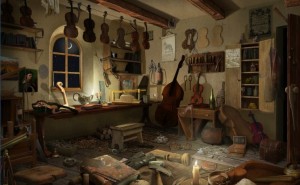This does not have much to do with guitar making, although there are about four guitars made by Stradivarius still in existence - perhaps I will do a blog on this in the near future - but as a violin maker as well, I find the history of the violin and how little has changed over centuries,makes this a fascinating and wonderful instrument.
Cremona is truly a great city to visit. It is an old city with some interesting ancient history and it is steeped in the tradition of music and instrument making. The whole feel of the city is centred around music and if you want to see old violins, their museums are well stocked. Below is some interesting information on some of the master violin makers courtesy of Martin Gani.
The golden age of violin-making in Cremona began with Andrea Amati (1505-1577) who is considered the pioneer of the modern violin.  His grandson NiccolA? Amati (1596-1684) made some significant improvements, both aesthetically and acoustically. Guarneri del GesA? (1698-1744) made robust instruments with a powerful, rich sound, qualities so admired by the virtuoso violinist and composer Paganini that he owned four of them. But the city owes its fame to the inimitable master of all time Antonio Stradivarius (1644-1737). Stradivarius crafted around 1,100 string instruments, mostly violins, of which half are still in existence. He became rich and famous in his own lifetime, violinists and collectors alike started salivating over his instruments soon after he set up shop in Cremona in 1670. In 1990 a Stradivarius violin was sold for a record $1.4m. In April 1998, Stradivarius broke his own record when his violin,Kreutzera, auctioned by Christiea's in London, fetched $1.58m. The owner had paid $24,000 for it in 1958. Alas, Kreutzera's primacy didn't last long. On 1st November 1999 the Swiss music dealers Hug announced that the violin owned by Yehudi Menuhin (1916-1998), a 1742 gem by Giuseppe Guarneri, had just been auctioned for $2.83m.
His grandson NiccolA? Amati (1596-1684) made some significant improvements, both aesthetically and acoustically. Guarneri del GesA? (1698-1744) made robust instruments with a powerful, rich sound, qualities so admired by the virtuoso violinist and composer Paganini that he owned four of them. But the city owes its fame to the inimitable master of all time Antonio Stradivarius (1644-1737). Stradivarius crafted around 1,100 string instruments, mostly violins, of which half are still in existence. He became rich and famous in his own lifetime, violinists and collectors alike started salivating over his instruments soon after he set up shop in Cremona in 1670. In 1990 a Stradivarius violin was sold for a record $1.4m. In April 1998, Stradivarius broke his own record when his violin,Kreutzera, auctioned by Christiea's in London, fetched $1.58m. The owner had paid $24,000 for it in 1958. Alas, Kreutzera's primacy didn't last long. On 1st November 1999 the Swiss music dealers Hug announced that the violin owned by Yehudi Menuhin (1916-1998), a 1742 gem by Giuseppe Guarneri, had just been auctioned for $2.83m.

